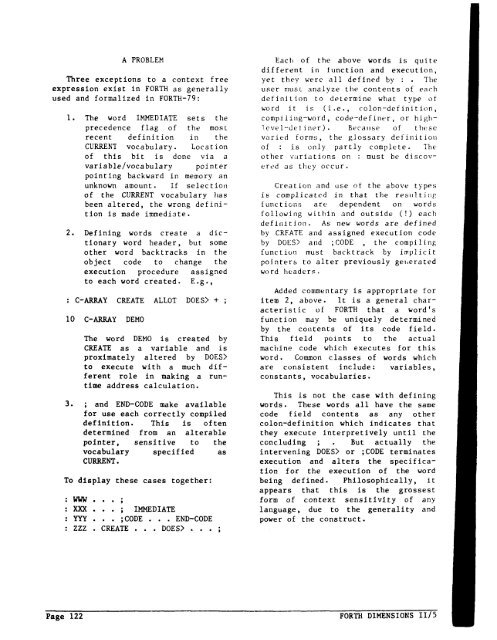5 - Forth Interest Group
5 - Forth Interest Group
5 - Forth Interest Group
Create successful ePaper yourself
Turn your PDF publications into a flip-book with our unique Google optimized e-Paper software.
A PROBLEM<br />
Three exceptions to a context free<br />
expression exist in FORTH as generally<br />
used and formalized in FORTH-79:<br />
1. The word IMMEDIATE sets the<br />
precedence flag of the most<br />
recent definition in the<br />
CURRENT vocabulary. Location<br />
of this bit is done via a<br />
va r i a b 1 e / voca bu la r y pointer<br />
pointing backward in memory an<br />
unknown amount. If selectioti<br />
of the CURRENT vocabulary has<br />
been altered, the wrong defini-<br />
tion is made immediate.<br />
2. Defining words create a dic-<br />
tionary word header, but some<br />
other word backtracks in the<br />
object code to change the<br />
execution procedure assigned<br />
to each word created. E.g.,<br />
: C-ARRAY CREATE ALLOT DOES> + ;<br />
10<br />
3.<br />
C-ARRAY DEMO<br />
The word DEMO is created by<br />
CREATE as a variable and is<br />
proximately altered by DOES><br />
to execute with a much dif-<br />
ferent role in making a run-<br />
time address calculation.<br />
; and END-CODE make available<br />
for use each correctly compiled<br />
definition. This is often<br />
determined from an alterable<br />
pointer, sensitive to the<br />
vocabulary specified as<br />
CURRENT.<br />
To display these cases together:<br />
: w w w . . . ;<br />
: XXX . . . ; IMMEDIATE<br />
: YYY . . . ;CODE . . . END-CODE<br />
: ZZZ . CREATE . . . DOES> . . . ;<br />
Each of the above words is quite<br />
different in function and execution,<br />
yet they were all defined by : . The<br />
user r.iusL analyze the contents of each<br />
definition to determine what type of<br />
vord it is (i.e., colon-definition,<br />
compi iiiig-word, code-def iner, or high-<br />
:evel--dct incr). Becaiise of tticise<br />
varied forms, the glossary definition<br />
of : is only partly complete. The<br />
other vxriations on : must be discov-<br />
ered 3s they occur.<br />
Creation and use of the above types<br />
is complicated in that the resi~lti~g<br />
functioiis are dependent on words<br />
following within and outside (!) each<br />
defiriition. As new words are defined<br />
by CRFATE and assigned execution code<br />
by DOES> and ;CODE , the compiling<br />
function must backtrack by implici&<br />
pojnters to alter previously geiterclted<br />
word headers.<br />
Added commentary is appropriate for<br />
item 2, above. It is a general char-<br />
acteristic of FORTH that a word's<br />
function may be uniquely determined<br />
by the contents of its code field.<br />
This field points to the actual<br />
machine code which executes for this<br />
word. Common classes of words which<br />
are consistent include: variables,<br />
constants, vocabularies.<br />
This is not the case with defining<br />
words. These words all have the same<br />
code field contents as any other<br />
colon-definition which indicates that<br />
they execute interpretively until the<br />
concluding ; . But actually the<br />
intervening DOES> or ;CODE terminates<br />
execution and alters the specifica-<br />
tion for the execution of the word<br />
being defined. Philosophically, it<br />
appears that this is the grossest<br />
form of context sensitivity of any<br />
language, due to the generality and<br />
power of the construct.<br />
Page 122 FORTH DIMENSIONS II/5
















